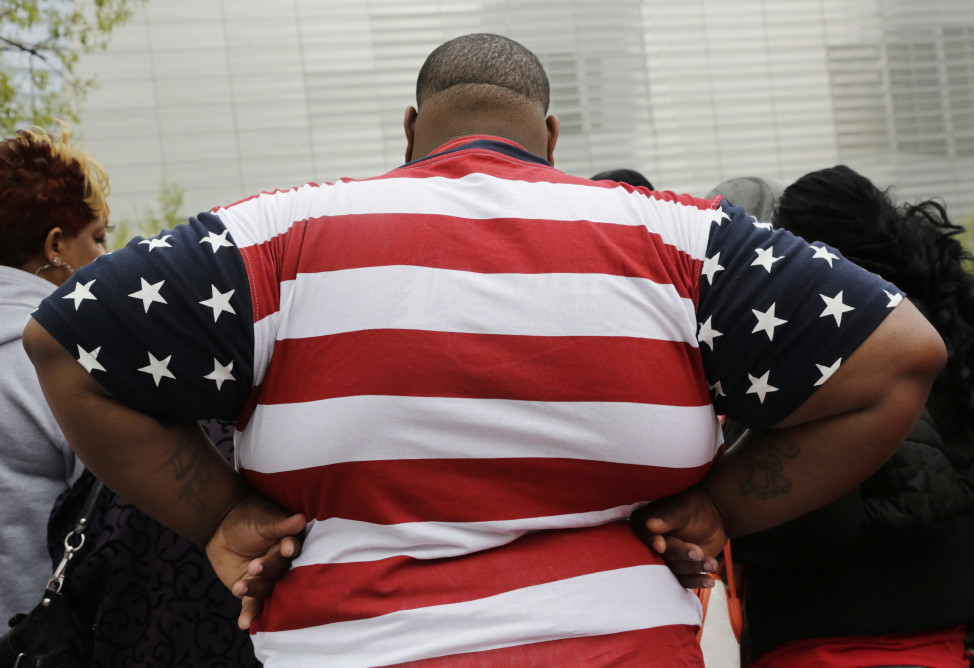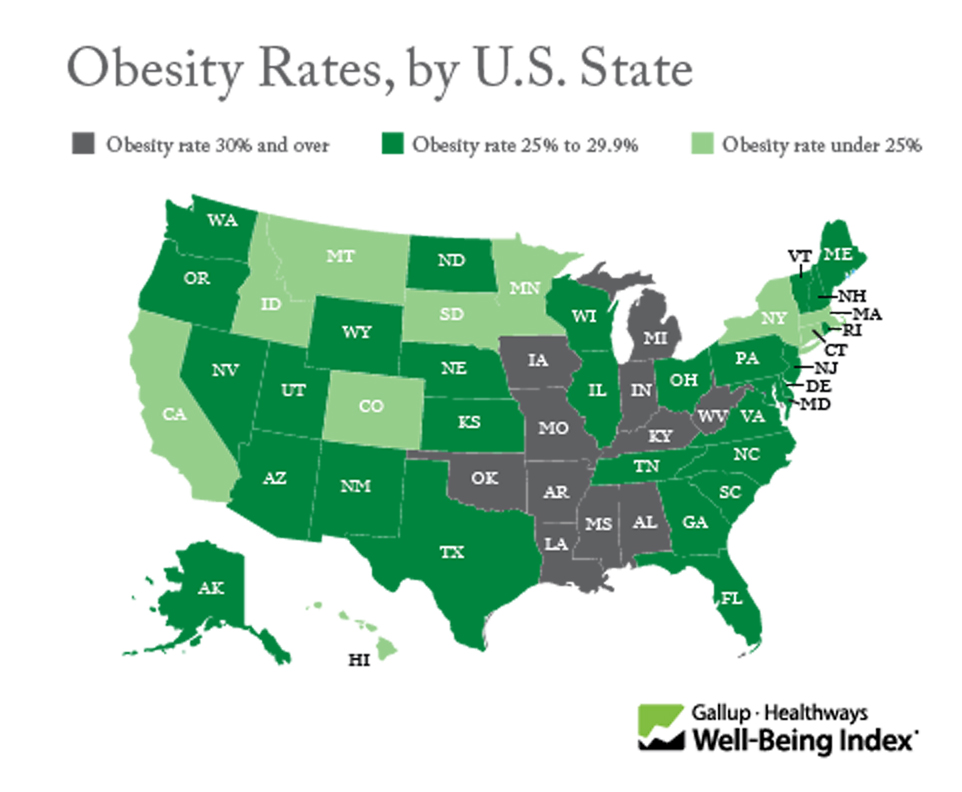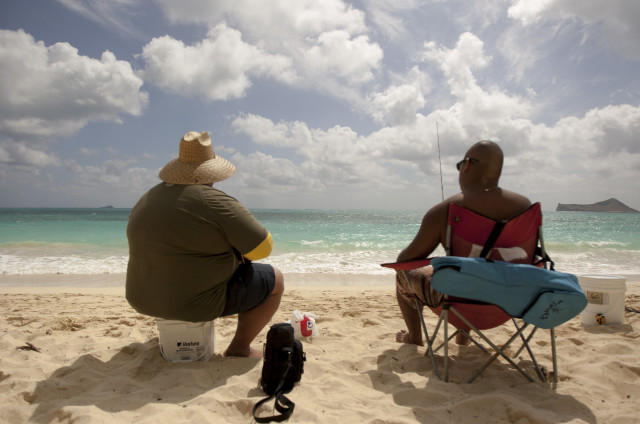
In this Thursday, May 8, 2014 photo, an overweight man wears a shirt patterned after the American flag in New York. (AP Photo)
Americans are fatter than ever.
The U.S. obesity rate climbed to 27.7 percent in 2014, up from 27.1 percent in 2013, and significantly higher than the 25.5 percent recorded in 2008, when Gallup first began tracking obesity.
“With roughly 250 million American adults, a couple of percentage points means there’s over 5 million more people who are obese today than were obese back in 2008 in the U.S.,” said Dan Witters, research director for the Gallup-Healthways Well-Being Index. “More states are getting fatter than are getting slimmer. It’s sobering but not surprising.”
Mississippi (35.2%) and West Virginia (34.3%) continue to have the top two obesity rates in the nation as they have since 2012. More than one-third of all residents in those states are obese. Along with Mississippi and West Virginia, the states of Louisiana, Arkansas and Kentucky have been among the top 10 fattest since 2008.
The usual suspects are contributing to the obesity epidemic in America: desk jobs, lack of exercise and bigger-than-ever portions.
“We’ve engineered natural movement out of our daily lives and while doing that the caloric density of food has continued to go up and those two things certainly aren’t helpful in reducing obesity,” said Janet Calhoun, senior vice president at Healthways.

To make matters worse, the truth is that the obesity epidemic in America is probably even more dire than the above numbers suggest because these statistics are all based on self-reported heights and weights and, well, people have been known to lie about how much they weigh.
“The actual obesity percentages are going to be about 20 to 25 percent higher than what’s reported,” Witters said, “so if you think it’s bad now, when you layer in that handicap, it’s probably a little higher and all the more reason to feel alarm over the trends that we see.”
Whatever the true numbers, overall obesity rates are highest in the Southern and Midwestern states and lowest in the Western and Northeastern states. A person who has a body mass index (BMI) of 30 or higher is considered obese, according to the Centers for Disease Control.
The 10 states with the lowest obesity rates since 2008 include California, Massachusetts, Colorado and Connecticut, while Delaware, Hawaii, South Dakota, Alaska and Tennessee had the best reduction in obesity levels between 2013 and 2014.
Nevada, New Mexico, Alabama and Minnesota had statistically significant increases in obesity in 2014, while only Tennessee was the only state to see a statistically significant decline in obesity.

Waimanalao Bay Beach Park in Waimanalo, Hawaii, May 19, 2015. Hawaii is the only state where fewer than one in five residents is obese. (AP Photo)
Gallup and Healthways have found a strong link between obesity and the overall well-being of Americans. States with lower obesity rates generally have the highest overall well-being.
“With such a large percentage of Americans being overweight or obese, it really has become, unfortunately, the social norm,” said Calhoun. “It used to be that when the [obesity] percentages were much smaller, people noticed so we really have to be serious about how do we reset what the social norm is around our health as Americans.”
Obesity can be a costly business in the United States. Obese people miss more days at work and utilize $1,500 more per year in healthcare costs more than their normal-weight counterparts. Gallup-Healthways found that, as a group, full-time U.S. workers who are overweight or obese and have other chronic health conditions miss an estimated 450 million more days of work than healthy workers. That absenteeism results in about $153 billion in lost productivity each year.
“It’s no joke,” Witters said. “It adds up to pretty big bucks.”
At least the situation is sunnier in in the Aloha state, the nation’s slimmest, where 19 percent of people are obese. Fewer than one in five people is obese in Hawaii. Other states that consistently have low obesity rates are Colorado, California, Massachusetts and Connecticut.
Results were based on telephone interviews with 176,702 adults conducted in 2014.






















Start by increasing health care premiums based on BMI. If the obese are using more health care services, there should be an associated health care premium increase. While this is not a fix to a huge problem, you have to start somewhere. Next, start with intense nutrition education and physical education classes in the schools. School lunches too need to be overhauled offering healthy choices only.
“School lunches too need to be overhauled offering healthy choices only.”
Fat americans wont have that! People will be up in arms if you touch their “FOOD”
Some obesity is caused by toxicity. We are surrounded by toxic chemicals and some of these get into the human body. Unfortunately, the body is not always able to get these toxins out, so those that it cannot get out it has to store somewhere long-term. Now many toxins have to be stored in fat cells, and there are plenty of fat cells already in the brain and the central nervous system. Unfortunately, these are sensitive tissues and therefore frequently the body does not want to store toxins there. So what to do? If the body has toxins that it cannot get rid of and has to store in fat cells but does not want to store in existing fat cells, then the only solution is to create new fat cells and store them there. This makes it possible to store chemicals and at the same time keep them out of the brain and the central nervous system. This protects the brain and the central nervous system, but also creates a problem of overweight. The best solution of course is for persons suffering from this kind of obesity to detoxify and get the chemicals out of the body. Once that is done, it becomes a rather easy task to take the extra weight off.
Balance has always been and will always be the key to everything 🙂